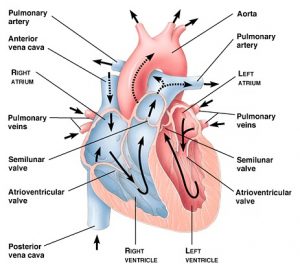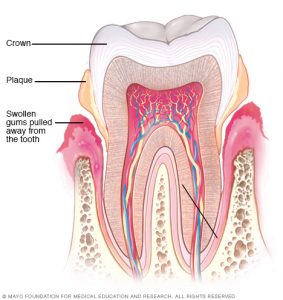Header logo
header top contact widget
Receded Gums
What’s Keeping You From Dental Visits?
Posted on Jan 10, 2018 by William J. Claiborne, DDS MS
You know how stressful it can be to go to the Ophthalmologist and have that puff of air shot into each eye. While it’s a necessary part of an annual eye exam, it tends to be the most dreaded part of the appointment, even moreso than having our eyes dilated.
Although a puff of air in our eye is not going to cause pain, going to the dentist, for some, creates an anticipation of pain. Even for visits that do not require numbing, some patients perceive pain to the extent that they actually feel it.
We see these patients all the time. In my office, we provide the specialized dental services of periodontal therapy (for treating all stages of gum disease) and dental implant diagnosis and placement. And, we stay pretty busy. 
It is estimated that over 47 percent of American adults have some level of gum disease. (https://www.perio.org/consumer/cdc-study.htm) Because gum disease is the leading cause of adult tooth loss, our day involves a full schedule of treating gum disease and replacing teeth.
There are a number of reasons that people avoid dental visits, ranging from not understanding the importance of these visits (assuming “if it doesn’t hurt, then nothing is wrong”) to having limited funds. While it may seem that most adults avoid regular dental care because of dental fear, that’s just one of the reasons.
In a 2014 survey of 965 respondents (published by the American Dental Association: https://www.ada.org/~/media/ADA/Science%20and%20Research/HPI/Files/HPIBrief_1114_1.ashx), the top three reasons for not seeing a dentist on a regular basis were cost, not feeling a visit was needed, and not having the time.
For me, this shows a nonchalant attitude among our adult population when it comes to the importance of oral health. Research has already linked the bacteria of gum disease to serious health issues. These include heart disease, stroke, diabetes, arthritis, preterm babies, erectile dysfunction and some cancers. Research is now delving into the connection between this bacteria and Alzheimer’s Disease. Why is oral health still a low priority with so many?
Although Americans love the look of a bright, white smile, the health of your gums is far more important than the shade of your teeth. Just because “nothing hurts” doesn’t mean an individual has a healthy mouth.
I believe the misconception of the value of healthy gums is partly due to the silent development of gum disease. For example, an early warning sign is seeing blood in the sink when brushing, yet many people assume that’s normal or even a sign they’re doing a good job.
One of the reasons that pancreatic cancer is so deadly is that, by the time symptoms become obvious, the disease is so far along that treatment is rarely effective. The same is true for oral cancer, which has one of the worst survival rates of all cancers. While regular screenings are advised for colon, breast, uterine, prostrate and skin cancers, the simple and inexpensive path to maintaining a healthy smile hasn’t been given nearly enough publicity.
Losing teeth is no small issue. When natural tooth roots are no longer present in the jaw bone, the bone begins to shrink, or resorb. This thinning jaw bone leads to a number of problems, including changes in facial appearance as well as a compromised ability to properly bite and chew.
If the eyes are the ‘windows to the soul,’ the mouth is the door to the body. Taking good care of your gums will help you keep your natural teeth and avoid the risks associated with the potent bacteria of gum disease.
This year, be determined to improve your overall health by being committed to good oral health. See your dentist twice this year and discuss an at-home oral hygiene routine that will help you maintain a healthy smile between visits.
If you are experiencing any of the following signs of gum disease, call 828-274-9440 for an examination as soon as possible. Gum disease only worsens without treatment. Watch for: sore gums that bleed when brushing, swollen gums, gums that pull away from teeth and expose tender tooth root areas, persistent bad breath, and gums that darken to a red color.
Whitening Teeth Won’t Give You A Healthy Smile
Posted on Jan 05, 2018 by William J. Claiborne, DDS MS
Imagine riding in a friend’s car and hearing an unusual pinging obviously coming from under the hood. Let’s say you eventually mention the strange noise, only to have the friend reply, “Oh yes, I’ve been hearing it for a month but am thinking of having the car painted.”
Huh? Although it makes no sense to ignore a problem, it makes less sense that someone would choose to mask it over so they can continue to ignore it.
This is what happens, occasionally, when it comes to tooth whiteners. Although the appearance of bright, white teeth allude to having ‘clean’ teeth, the facade quickly falls away when it comes to the gums.
Having poor oral health reveals itself in several ways. In your own mouth, symptoms of periodontal disease may include tender gums that bleed easily when brushing and swollen gums in certain areas (often near back teeth).
For others, however, white teeth won’t camouflage poor dental health. An unhealthy smile may be obvious to others in the form of bad breath and a smile that shows signs of gum recession (gums that pull away from teeth, exposing tender tooth root segments) or even gums that are darker in color versus a healthy pink.
In conversations with fellow dental practitioners, we are always concerned when patients seem less concerned about having good oral health and more concerned about the appearance of their smiles. And then again, we are not surprised. It’s human nature to want to be appealing to others.
In an article published in The Cut, it included findings from one study that revealed how human nature subconsciously distorts our opinions when it comes to pretty people, even though we don’t want to acknowledge the prejudice (https://www.thecut.com/2016/05/hot-people-experience-life-differently.html):
“Harvard economist Markus Mobius and Wesleyan University economist Tanya Rosenblat published the seminal paper “Why Beauty Matters” in 1994. They found that in three different samples of workers, more attractive people consistently earned 12 to 14 percent more than unattractive people — regardless of gender — with evidence that the “labor market sorts the best-looking people into occupations where their looks are productive.” To that end, a 2012 paper found that comely real estate brokers outperformed homely colleagues. More uncomfortably, first- and sixth-graders think attractive teachers are kinder and happier, and college students thought that attractive professors were clearer, more helpful, and of higher overall quality.”
Perhaps this is what motivates adults to place such a high priority on appearance, even when they realize there is a health issue they should tend to that’s more important.
Another reason may be because the symptoms of gum disease and other problems in the mouth are often easy to ignore. For instance, like body odor, our sense of smell becomes accustomed to particular scents. Therefore, it’s easy to be unaware of our own bad breath.
And, gum disease may be running rampant without obvious symptoms or signs that cause alarm. For example, some people assume that seeing blood in the sink when brushing is a sign they’re doing a good job. They don’t associate it as a symptom of gum disease.
Before you invest in a tooth whitening kit at the drug store, ask your dentist to evaluate your oral health. If your gums are healthy, he or she will give you a thumbs up. Plus, healthy gums will be less sensitive during the whitening process.
If, however, your gums have indications of gum disease, whitening your teeth is doing your smile no favors. Save your money and put it towards a healthy smile first. Your teeth and gums (along with fresh breath) will send a message of a health-conscious individual. That’s always impressive!
If you’re experiencing any of the signs of gum disease mentioned above, please call for an examination. Gum disease only worsens without treatment. It is also the nation’s leading cause of adult tooth loss.
Call 828-274-9440.
New Study Finds Clogged Arteries More Connected To Oral Bacteria Than Fatty Foods
Posted on Nov 13, 2017 by William J. Claiborne, DDS MS
For years, we’ve been led to believe that the main cause of clogged arteries is the cholesterol-rich diet we consume. However, a recent study published by the Journal of Lipid Research has found fat molecules unrelated to butter, fatty animal meats and eggs may be the true source.
According to an article in Medical News Today (https://www.medicalnewstoday.com/articles/319967.php), the University of Connecticut (Storrs) conducted a study showing the fat molecules in plaque that are typically blamed for clogged arteries may actually originate from oral and gut bacteria.
In past studies, researchers have known there are strong connections between the bacteria of gum disease and an increased risk of heart attack and stroke. Yet, pinpointing the precise cause-&-affect has been elusive. This study may have tracked down the intricate path.
Atherosclerosis occurs when fat molecules, calcium, cholesterol, and other compounds in the blood form plaque on the inside walls of arteries. These arteries are what carry oxygen via the bloodstream to the heart, brain, kidneys, and other parts of the body.
When plaque accumulates, it can harden and narrow the arteries, thus depriving oxygen-rich blood to vital organs and tissues. This can lead to heart attack, stroke, other serious health problems and, in some instances, even death.
For decades, it was assumed that the fatty molecules of atherosclerosis, or lipids, are the result of a diet rich in foods high in fat and cholesterol. Th is study focused on the formation of plaque (that include fat molecules) as well as other growths known as atheromas.
is study focused on the formation of plaque (that include fat molecules) as well as other growths known as atheromas.
Atheromas refer to fatty masses that develop in the artery walls. Their presence activates the immune system, which recognizes that the lipids are not of human origin. This, in turn, tends to trigger inflammation. Inflammation is what leads to the thickening of the smooth muscles that line artery walls.
When the research team analyzed atheromas of hospitalized patients, they found the chemical makeup of lipids were not from animals. Rather, the fat molecules matched bacteria belonging to the Bacteroidetes family.
Bacteroidetes, fatty acids that do not have the same features as animal fat, are not typically harmful. They exist in the mouth and, in some situations, can activate gum disease but are not known to invade blood vessels. The culprit, however, lies in the lipids they secrete, which can penetrate cell walls and enter the bloodstream.
Apparently, it is an enzyme that breaks down the bacterial lipids that can activate a process that manufactures molecules that promote inflammation. When the immune system encounters the bacteria and then couples with the enzyme that creates inflammation, their combined actions can lead to an even higher risk for the formation of plaque.
The researchers are continuing efforts to further study how atheromas form where Bacteroidetes lipids accumulate. They are seeking even more evidence that fat molecules from Bacteroidetes are linked to atheroma growth, and thus to heart disease.
In the meantime, we certainly encourage you to eat a diet low in cholesterol. Yet, keep this study in mind as reinforcement to the need to maintain good oral health. For decades, research has shown the close relationship of oral health and overall health.
In addition to heart disease and stroke, past research has correlated the bacteria of periodontal (gum) disease to diabetes, arthritis, preterm babies, some cancers and impotency. Obviously, this is potent bacteria and keeping its accumulation to a minimum is beneficial to your overall health.
Is is important to know the signs of gum disease. Seeing blood in the sink while brushing, tender or swollen gums, frequent bad breath, and gums that pull away from teeth and expose sensitive tooth roots are just a few of the signs. Without treatment, gum disease will only worsen. It affects over 47 percent of American adults and is the leading cause of adult tooth loss.
Protect your smile and your overall health. In addition to a thorough at-home commitment to oral hygiene, have twice-yearly dental check-ups and watch for signs of gum disease. If you suspect gum disease exists, call 828-274-9440 to schedule an exam. This will be the first step to protecting your smile, and apparently, your heart!
Afraid Of Going To The Dentist? Fear Has Big Price Tag.
Posted on Aug 15, 2017 by William J. Claiborne, DDS MS
In my periodontal specialty, I see a large number of patients who have developed gum disease or have lost teeth because they were too afraid to go to a dentist. Some people have even avoided dental care for decades. Yet, like a leaky roof on a house, ignoring the problem only leads to bigger, more complicated issues to deal with eventually that can’t be avoided.
Dental fear is a major problem in the U.S. and is a contributing factor to developing periodontal disease. Because gum disease begins without obvious warning signs, it is often allowed to develop further. This can create more complex problems and the need for treatment that is more involved and costly than if caught early on.
Gum disease, at some level, affects over 47% of American adults. However, most Americans are unfamiliar with the typical warning signs. These include tender gums that bleed easily when brushing, bad breath and swollen gums. As the disease progresses, gums become redder from inflammation and may recede from teeth, exposing tooth roots segments that are sensitive to hot and cold.
While it is estimated that over 70% of adults have some level of dental fear, from anxiety to dental phobia (an uncontrollable reaction that causes some adults to shake, sweat or even cry when faced with a dental visit), there is no typical persona when it comes to who has dental fear and who does not. There is no common age, gender or educational level, nor is there a typical income level.
What is ‘normal,’ so to speak, is the fact that most dental fear exists because of a traumatic experience in a dental chair in the past. This may have been as a child when a dentist was too rough or forceful. It may have been as an adult when the patient was not yet numb, yet the dentist continued to work on a tooth.
Dental fear, once embedded in the brain, often triggers perceived pain in the future. What exacerbates it is how it leaves a patient feeling vulnerable. When reclined in a treatment chair and unable to see what is taking place in a sensitive area such as the mouth, there is a sense of not being in control. For those who have experienced pain thrust upon them in the past that continued beyond their pleas, this sensation of helplessness is not something that is easily overcome.
In our office, we frequently see patients because they are beyond what can be treated by a general dentist. A Periodontist specializes in all levels of gum disease. This means that we have the best potential to help you save your natural teeth, even when at advanced levels.
While red, inflamed gums may not sound highly serious, they are. Research has shown that the oral bacteria of periodontal disease can enter the bloodstream and create inflammatory reactions. This is known as systemic inflammation. This inflammation has been linked to serious health problems including pre-term babies, heart disease, stroke, diabetes, arthritis, high blood pressure, some cancers, impotency and even Alzheimer’s disease.
Apparently, healthy gums are important to having good, overall health. Your periodontal wellness is important and dental fear can be addressed so you can achieve a healthy, confident smile without feeling white-knuckled in the dental chair! We offer oral sedation, which is in pill form, for relaxation. We also offer I.V. sedation that creates a “twilight sleep” state.
Both sedation options are safe. Trained staff monitor sedated patients throughout treatment using special safety equipment. Both tend to erase most, if not all, memory of treatment afterward and recovery for both is fairly quick. Within hours for oral sedation and without 24 hours for I.V. sedation.
However, as a dental specialist AND a caring, compassionate caregiver, I have seen patients relax the most when they realize our goal is to make sure they are always comfortable. We never want a patient to feel helpless or vulnerable in our dental chair. Once a new patient explains their concerns about comfort and we discuss options to keep them relaxed and comfortable, we will determine – together – the best sedation and pace of treatment that fits.
Consider beginning with a consultation appointment so we can get to know one another. We can arrange to meet in our private consultation room that is removed from the clinical side of the practice. Here, we’ll sit in comfy arm chairs and have a conversation about your specific needs.
Call 828-274-9440 and let’s get your smile in great shape! After all, having a smile that looks as good as it feels is a reason, in itself, to smile!
Recent Posts
Categories
Archives
- September 2024
- August 2024
- July 2024
- June 2024
- May 2024
- April 2024
- March 2024
- February 2024
- January 2024
- December 2023
- November 2023
- October 2023
- September 2023
- August 2023
- July 2023
- June 2023
- May 2023
- April 2023
- March 2023
- February 2023
- January 2023
- December 2022
- November 2022
- October 2022
- September 2022
- August 2022
- July 2022
- June 2022
- May 2022
- April 2022
- March 2022
- February 2022
- January 2022
- December 2021
- November 2021
- October 2021
- September 2021
- August 2021
- July 2021
- June 2021
- May 2021
- April 2021
- March 2021
- February 2021
- January 2021
- December 2020
- November 2020
- October 2020
- September 2020
- August 2020
- July 2020
- June 2020
- May 2020
- April 2020
- March 2020
- February 2020
- January 2020
- December 2019
- November 2019
- October 2019
- September 2019
- August 2019
- July 2019
- June 2019
- May 2019
- April 2019
- March 2019
- February 2019
- January 2019
- December 2018
- November 2018
- October 2018
- September 2018
- August 2018
- July 2018
- June 2018
- May 2018
- April 2018
- March 2018
- February 2018
- January 2018
- December 2017
- November 2017
- October 2017
- September 2017
- August 2017
- July 2017
- June 2017
- May 2017
- April 2017
- March 2017
- February 2017
- January 2017
- December 2016
- November 2016
- October 2016
- September 2016
- August 2016
- July 2016
- June 2016
- May 2016
- April 2016
- March 2016
- February 2016
- January 2016
- December 2015
- November 2015
- October 2015
- September 2015
- August 2015
- July 2015
- June 2015
- May 2015
- April 2015
- March 2015
- February 2015
- January 2015
- December 2014
- November 2014
- October 2014
- September 2014
- August 2014
- July 2014
- June 2014
- May 2014
- April 2014
- March 2014
- February 2014
- January 2014
- December 2013
- November 2013
- October 2013
- September 2013
- August 2013
- July 2013
- June 2013
- May 2013
- April 2013
- March 2013
- February 2013
- January 2013
- December 2012
- November 2012
- October 2012
- September 2012
- August 2012
- July 2012
- June 2012



